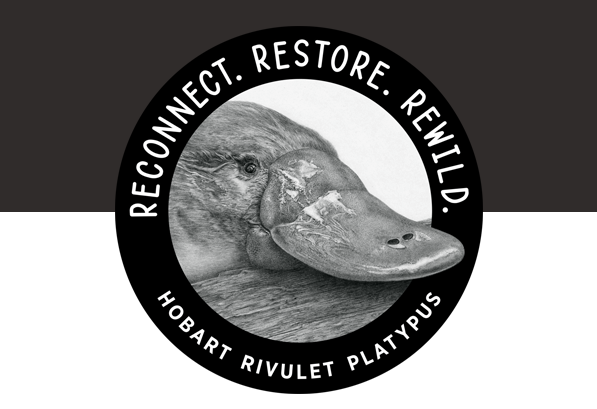Where is the best place to see platypus in Tasmania?
The Platypus Guardian documentary raised the profile of Hobart’s urban platypus population, but there are far better places in Tasmania to see platypuses.
By ‘better’ we mean places where you are far more likely to see a platypus, and places where the platypus population is less stressed by human disturbance, pollution and habitat destruction.
Please consider spreading the platypus love across Tasmania by visiting the destinations below.
The North West corner of Tasmania is a platypus stronghold, with the local towns of Deloraine and Latrobe vying to be ‘The Platypus Capital of Australia’.
Our top locations to see platypus in Northern Tasmania include:
- Meander River, Deloraine
- Warrawee Reserve, Mersey
- Fernglade Platypus Trail, Burnie
- The Tasmanian Aboretum, Devonport
- Platypus House (in captivity)
If you’re visiting Southern Tasmania, we recommend:
Still stuck on the idea of seeing a platypus in the Hobart Rivulet?
Walk from the CBD to Cascade Gardens along the Rivulet Cycling and Walking trail. Keep your eye on the waterway. You might see a Hobart Rivulet platypus!
Along the way, take a short detour to visit the community funded platypus mural on Wynyard St, South Hobart. You’ll definitely see a HUGE platypus there 24/7, and Bear with me cafe serves great coffee and food!
What is the best time of year to see a platypus in Tasmania?
Any time of the year is a great time to see a platypus in Tasmania. That said, they tend to be out during the day more often:
- during colder months when more energy i.e. food, is required to maintain body temperature
- during the breeding season (October-December in Southern Tasmania)
What is the best time of the day to see a platypus?
Tasmanian platypus make their own rules, and are often seen during the day.
This could possibly be due to the lack of predators compared to the mainland e.g. there are no foxes in Tasmania.
It could also be climate based, with lower temperatures in Tasmania creating higher energy requirements, leading to extended foraging.
Some Tassie platypuses forage throughout the day, others forage throughout the night. Some are in sync with the cycle of the moon, others seemingly ignore it. Some come and go like clockwork every day, others not. And a platypus’s schedule can change at any time!
Basically, with the exception of a hot Summer’s day, any time of the day is a good time of day to see a platypus in Tasmania.
What’s the plural of platypus?
Platypuses or platypus. Platypi is often incorrectly used. Platypodes is the most correct plural but its use has never gained popularity.
How long do platypuses live for?
In wild nature, it’s believed platypuses live on average 7-14 years. In urban areas it has been reported their life expectancy decreases to 6-7 years.
In February 2024, a tagged 24 year old male platypus was found in a Melbourne creek – the oldest-known wild platypus!
The oldest platypus on record is Fleay, who turned 30 in October 2023. She was rescued as a nestling and has lived in captivity ever since at Healesville Sanctuary, Melbourne Australia.
How many platypuses are there in the Hobart Rivulet?
It’s almost impossible to know exactly how many platypus are in any waterway – unless there are none. Based on our monitoring of Hobart’s urban platypus population over the last three years we would say low to mid double digits feels about right.
How long can a platypus stay underwater?
While foraging, platypus typically stay underwater for 1-2 minutes. When threatened platypuses are able to stay underwater for up to 10 mins. This is achieved by wedging their body under a submerged log, overhang etc and slowing their heartbeat to 10 bpm or less.
What noise does a platypus make?
Platypus sometimes make a low electronic growl when distressed, but otherwise live in silence.
The rivulet is flooding! Will the platypus be ok?
Generally yes!
Platypus have instincts honed over millions of years when it comes to dealing with ever changing waterways. Like humans though, occasionally when caught in floods platypus may drown, become injured or displaced. Research has shown less experienced, weaker animals such as juveniles are more at risk.
It’s not uncommon to see adult platypuses out in flooding waterways using the current to their benefit e.g. accessing new food sources, using the current to facilitate foraging.
The main risk to platypus during and after flood is entanglement in our rubbish.
What do platypus eat?
Platypus are carnivorous, and are regarded as the apex predator of their world. They spend 12-16 hours each day foraging, dining mostly on water bugs but will also eat worms and yabbies.
Platypus generally eat 13-28% of their body weight every day. That may even increase to 100% for a lactating female.
Why do platypus have spurs?
Only male platypuses have spurs, located on the inside of each hind leg. The spurs are primarily used during the breeding season, as males fight to settle territory and mating rights. A spurring isn’t fatal to a platypus.
Male platypus may use spurs as a means of self defense. While the venom isn’t fatal to humans it is known to be extremely painful. There are records of dog deaths following spurring.
How big is a platypus?
From the tip of bill to tip of tail, platypus are between 40cm – 63cm long. They weigh between 0.8-3.0 kg. Males are ~25% larger than females.
As a rough guide, platypus are less than half the size of the average domestic cat.
What do Indigenous Australians call platypus?
Indigenous names for platypus include: Larila, Mallangong, Mallunggang, Tambreet, Billadurong, Tohunbuck, Gaya-dari, Boonaburra
How do you tell platypuses apart?
Like people, the longer you spend with platypuses, the more you appreciate how different each platypus is. Unlike people however, identifying a platypus can often require close up images and slow motion video – even when relatively close to the animal. Clues we rely on include:
- Overall coloring (brown fur/orange eye patch- grey fur/pale eye patch)
- Indents, markings on upper bill
- Eye patch shape and color variations
- Face mask variations
- Shield variations
- Pigmentation patterns on lower bill
- Pigmentation variations on legs and webbing
- Presence of spurs & spur characteristics
- Location
- Behaviour
- Size
- Body proportions
Why do platypus scratch so much?
Platypus are meticulous groomers, often seen using their sharp back claws to ‘brush’ their fur.
- Platypus must keep their fur waterproof
- They carry a number of parasitic animals in their fur, including a tick only found on platypus
- To distribute scent, especially during the breeding season
- They could be entangled in looped litter
What do I do if I see a platypus in the wild?
Firstly, don’t be that person who only wants to capture a social media moment. Sit quietly and let the platypus go about its business – you’ll be rewarded. Platypus aren’t there for your entertainment. They are busy trying to survive. Never chase a platypus or throw objects in the water.
What does platypus poo look like?
Fresh platypus poo looks like black mousse/soft serve ice cream but is tacky like hot tar. It also smells… a lot!
What time of year do platypus breed?
The further south, the later the breeding season for platypus. In Hobart the breeding season is November/December. Compare that to Queensland for example, where breeding is in the middle of the year.
What does Ornithorhynchus anatinus mean?
Ornithorhynchus anatinus, the scientific name for a platypus, means: Bird-like, duck-like. Not what you were expecting hey!
What does the word platypus mean?
Broad, flat feet.
What’s the correct name for a baby platypus?
Nestling is probably the most accurate name for a baby platypus. Puggle however is commonly used, after Taronga Zoo staff in 2003 suggested the name given to baby echidnas could also be used. Platypups has also been put forward.
Do platypus really glow in the dark?
The jury is actually still out on that one! Deceased platypuses in museums do glow under UV, possibly because of the chemicals they have been treated with. As far as we know, the glow hasn’t been replicated in the wild with wet or dry platypuses.
Do platypus hold their breath underwater?
Yes platypus hold their breath underwater. Occasionally they release a small amount of air from their nostrils, but generally the trail of bubbles you see on the surface is air escaping from the platypus’s fur.
Who teaches a nestling/puggle how to be a platypus?
Incredibly nobody! Young platypus must rely on the knowledge and instincts encoded into their being.
It is thought the survival rate of young platypus is approximately two out of every five.
Are platypus aggressive?
Platypus are not aggressive animals. Disputes in their world, usually over territory, are generally settled within a few short seconds of tumbling around in the water.
The exception to this is during the breeding season. Both male and female platypuses undergo significant hormonal changes during this time. The weight of the male testes for example increases by up to a factor of 20x! Males are far more territorial during this time, and will fight for breeding rights, including using their spurs on each other.
Why are platypus bigger in Tasmania?
Platypus in Tasmania weigh up to 3x more than platypus on mainland Australia. One possible explanation is that the colder the climate, the greater the thermal mass needed to efficiently maintain body temperature.
How large is a platypus's territory?
In a linear environment (along a waterway like the Hobart Rivulet) the length of a platypus’s territory AKA home range varies, largely dependent on resources available.
A dominant male’s territory can be up to 10km long. It generally contains several female territories. Male territories are less likely to overlap compared to females.
What does platypus fur feel like?
The fur on a platypus’s body is incredibly soft. The fur on its tail though is more like a wire broom. Platypus molt annually, following the breeding season.
Do platypus have a stomach?
Some time ago a news web site reported platypus do not have a stomach. Other sites soon repeated the claim. It was a case of fake news! Platypus do indeed have a stomach, just different to ours.
How does a female platypus feed its young?
A female platypus does not have nipples to feed its young. Instead milk oozes through its skin.
Nestlings rely solely on this milk until they leave the nesting burrow. Depending on the mother, that may or may not be followed by a short weaning period.
Where is the platypus mural located in Hobart?
The 10m x 3m platypus mural, painted by renowned contemporary Australian artist Jimmy Dvate is located on the corner of Macquarie & Wynyard Streets, South Hobart.
What does monotreme mean?
Monotremata means ‘one-holed’ in Greek, referring to the single duct (cloaca) used by animal’s urinary, defecatory, and reproductive systems.
Platypus and echidna are both monotremes.
How many eggs does a female platypus lay?
A nesting female lays 1-3 eggs.
Do platypus sweat?
Platypus are perfectly adapted to their cool world of waterways and burrows. They are however unable to sweat, and are prone to heat stress in temperatures 25 degrees celsius or higher.
Does the presence of platypus indicate a pristine waterway?
No. Platypus can tolerate significant levels of pollution.
Platypuses primary food source – water bugs – however, are sensitive to pollution. The higher the level of pollution, the fewer the waterbugs, the lower the density of the platypus population.
How do platypus stay warm?
Platypus are better than many mammals at regulating their body temperature. Theyare able to maintain a constant body temperature, even after spending many hours in water close to zero degrees celsius!
- Platypus have a lower body temperature than humans
- Platypus fur is more efficient than even polar bear fur, trapping a layer of air between the animal’s body and the water.
- Platypus have a dynamic metabolism that constantly balances energy in with energy out.
- Platypus have a ‘miraculous network’ that warms blood returning from extremities using blood leaving its core.
Do platypus have teeth?
Yes and No. Nestlings do have teeth that fall out before they emerge from the nesting burrow. Juvenile and adult platypus instead have grinding plates, which are far more practical in their world.
What does a platypus's bill feel like?
The bill of a platypus is rubbery. Squeeze your ear lobe. It feels like that, but a little firmer.
Do platypus in the wild play?
Not as far as we have observed. Generally platypus in the wild are busy surviving – either foraging for many hours every day, tending to their fur or sleeping in their burrow.
There have been reports of platypus in captivity exhibiting ‘play’ behaviour, but we tend to think it’s out of the platypus equivalent of boredom.




